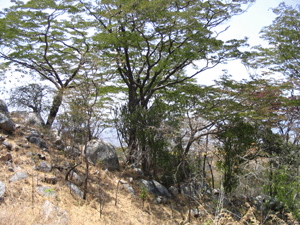Ruaha National Park

Six hundred kilometers to the west of Dar Es Salaam lies the beautiful Ruaha National Park. The largest national park in all of Africa it covers an area of 22,000 sq.km. The park is surrounded by vast areas of virtually untouched wilderness in the form of game reserves, bringing the total protected area to about 50,000 sq. km. The Great Ruaha River, a major geographical feature of the park, provides much of Tanzania's electricity as well as being a very important water source to the animals in the park.
Ruaha's unique ecosystem is shaped by a wide range of climatic types, from dry, hot, rift valley zones and riverine forests along the Great Ruaha River, to sweeping savannahs and cold mountain forests. Located at the convergence zone of northern and southern species, Ruaha is an extremely diverse ecological area that is home to several endemics, including the Ruaha Red-Billed Hornbill. An important habitat for endangered species such as the African Wild Dog, Ruaha is also the southern limit of the ranges of Grant's Gazelle and Striped Hyena. More than 400 species of birds are common to Ruaha, and it is the ony park in Africa where Roan and Sable Antelope and Greater and Lesser Kudu can be found together.
Conservation
FORS works closely with RUNAPA, WCS, and MBOMIPA in implementing its Environmental Education Program. We extend our heartfelt congratulations to MBOMIPA and the residents of Idodi and Pawaga Divisions for their successful bid to establish the Pawaga-Idodi Wildlife Management Area (PIWMA). We also applaud the Wildlife Division of the Ministry of Natural Resources and Tourism for its approval of and assistance in establishment of PIWMA.

The Great Ruaha River
The Great Ruaha River runs along the eastern boundary of Ruaha National Park, and is the lifeblood of the park and surrounding areas. However, as a result of intensive rice farming and livestock grazing in the Usangu catchment area the river has been drying up earlier and earlier every year since 1994. The reduced water flow is of great concern to everyone from conservationists to economists alike, as the Great Ruaha flows into the Mtera Dam source of much of Tanzania's electricity. FORS has long been involved in advocacy and awareness-raising about this issue, and we are happy to report that in early 2008 the Tanzanian Government added the Usangu Wildlife Management Area to Ruaha National Park, thus protecting the catchment area and making Ruaha the biggest park in all of Africa.
